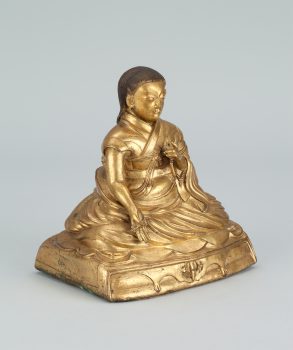Tibet
18th century
The right hand is extended in a giving gesture.
Tibet
18th century



This statue depicts a teacher, probably of the Sakya Buddhist tradition. In this portrait he is sitting in a meditative posture. He wears a monk’s robe, although his long hair and twisted locks mark him as a yogi, or tantric practitioner. In his left hand he holds what was probably a vajra bell, whose shell has since fallen off, with a strand of prayer beads hanging on his wrist. His right hand holds a vajra in the gesture of generosity (varada mudra). The holes in his earlobes suggest there were once earrings. His eyes are wide open, his face calm with a tender smile. His seat is covered with a deer skin, another symbol of a tantric practitioner.
The passing down of authentic Buddhist teachings from a teacher to a disciple or student, often in the form of a text in a ritualistic context.
The transmission of teachings from one generation to the next, from teacher to student, traced all the way back to the Buddha without interruption. A complete lineage is essential in Tantric Buddhist practices as it makes the blessings of the teaching more powerful.
Himalayan art includes portraits of legendary and historical humans, including accomplished religious teachers (lamas), the Buddha’s original disciples (arhats), and spiritually accomplished tantric masters (mahasiddhas).
Today, Tibetans primarily inhabit the Tibetan Plateau, situated between the Himalayan mountain range and the Indian subcontinent to the west, Chinese cultural regions to the east, and Mongolian cultural regions to the northeast. During the 7th to 9th century, Tibetan rulers expanded their empire across Central Asia, and established Buddhism as the state religion.
Get the latest news and stories from the Rubin, plus occasional information on how to support our work.